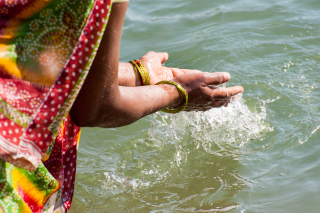
Posted by Priya Goel[1]
This is the story of the greening of the Alwar district in Rajasthan through “Shramdaan” or the use of local, free or donated labor for the creation of infrastructure assets. Rajasthan is India’s driest state. Alwar is an important agricultural district in the State, but only 12 percent of the land area is irrigated. Until 1985, Alwar was declared a ‘dark zone’ with no ground water. It had once been green. In 1985, a local doctor, Dr Rajendra Singh, discovered that the villagers needed water more than his medicines. He found that the drying up of groundwater had resulted from indiscriminate deforestation, mining, poor agricultural practices, and the abandonment of traditional techniques of rainwater harvesting.
Through his small NGO (Tarun Bharat Sangh) Dr Singh explained to the villagers that the environmental threats they were facing could be overcome through the conservation of rainwater and planting forests. The availability of ground water when rains fail leads to assured irrigation. Farmers are not dependant on the vicissitudes of nature for their livelihood. Farmer suicides due to crop failure are a common feature in India.
Together with the local village people Dr Singh manually constructed water holding dams called “Johads”. This is an old water conservation technique which creates catchment areas for rainwater where natural crevices exist, and tree plantation. Over time, the catchment areas started to fill up, the water table rose, and the river Arvari which had dried up became again a full-flowing river. Dr Singh set up “Pani Panchayats” (Water Management Committees) to manage the community’s water resources. This effectively gave the management of these assets to the community.
Dr Singh’s Johads received no funding from the Indian union (federal) government, the State of Rajasthan, or any multilateral funding agency. Roughly costed, using the prevailing wage rate in 2018, and on the assumption that approximately 100 villagers were engaged in the task of building Johads and that locally sourced materials were used, the financial outlay would be only Rs 80,000 (approximately USD 1,000). Compare this figure to the state government’s 2018-19 budget allocation for minor irrigation projects of about USD 73 million.
What are the lessons to be drawn for public investment from this story? The Shramdaan model is not new. As governments seek better ways to deliver public services, they have experimented with community-based delivery systems, including grant funding of many services through NGOs and public-private partnerships. This search continues. Clearly, however, only certain kinds of public infrastructure can be created and public goods provided through such local participation. The Shramdaan approach would not be possible or appropriate for large and complex capital infrastructure projects.
Governments can play an important role in identifying areas of policy which can be delivered through Shramdaan and similar community-based partnerships. It could be a relevant model for the creation of public assets and the delivery of services in many social sector programs such as education, health, water and sanitation where the government plays the role of catalyst and enabler. The government could finance some of the costs of community-based projects without taking away the ownership from the community. This would call for better monitoring and measurement tools and performance indicators and benchmarks.
If the community “owns” the assets created by these projects and the benefits to the community are direct and measurable, significant benefits can be realized in the form of greater transparency and accountability. There are other indirect benefits such as environmental awareness. As the budgetary funds are used as a catalyst, they can be leveraged many times, and the monetary benefits, both direct and indirect, should greatly outweigh the costs. As governments in many developing countries seek more effective ways to create public assets, the use of models in which the government partners with local communities is worth exploring further.
[1] Priya Goel is a financial management specialist who previously worked with the World Bank and the United Nations.
Note: The posts on the IMF PFM Blog should not be reported as representing the views of the IMF. The views expressed are those of the authors and do not necessarily represent those of the IMF or IMF policy.







